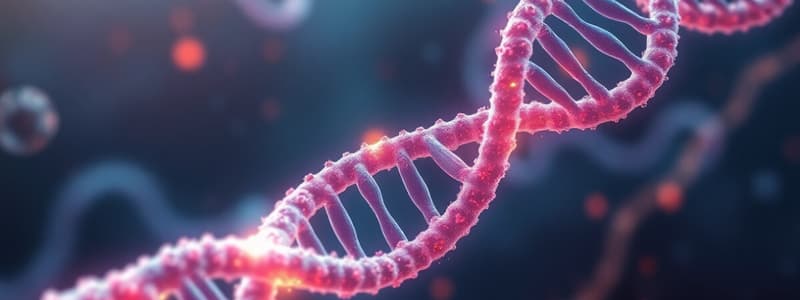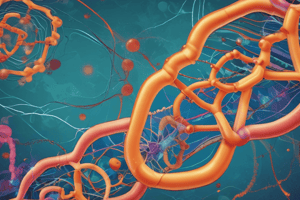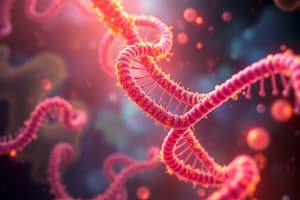Podcast
Questions and Answers
At which of the following levels can gene expression be controlled in cells?
At which of the following levels can gene expression be controlled in cells?
- Transcription
- Translation
- Post-translation (protein activation)
- All of the above (correct)
Positive control in gene regulation occurs when a regulatory protein binds to DNA and shuts down transcription.
Positive control in gene regulation occurs when a regulatory protein binds to DNA and shuts down transcription.
False (B)
What is the name given to the regulatory region on the DNA where DNA-protein interactions occur?
What is the name given to the regulatory region on the DNA where DNA-protein interactions occur?
operator
The preferred carbon source for E. coli is ________, and it only uses lactose when this is depleted.
The preferred carbon source for E. coli is ________, and it only uses lactose when this is depleted.
Which of the following is the function of the lacZ gene?
Which of the following is the function of the lacZ gene?
The lacI gene encodes the Lac repressor, which, when bound to the operator site, can block the expression of the lacZYA genes.
The lacI gene encodes the Lac repressor, which, when bound to the operator site, can block the expression of the lacZYA genes.
What must happen in order for expression of the lacZYA genes to be induced?
What must happen in order for expression of the lacZYA genes to be induced?
The breakdown product of lactose, also known as a catabolite, prevents the activation of the lac operon, a process known as ________ ________.
The breakdown product of lactose, also known as a catabolite, prevents the activation of the lac operon, a process known as ________ ________.
In the context of the lac operon, what is the role of allolactose?
In the context of the lac operon, what is the role of allolactose?
When glucose is abundant, adenylate cyclase is activated to convert ATP to cAMP.
When glucose is abundant, adenylate cyclase is activated to convert ATP to cAMP.
What effect does the binding of the CAP-cAMP complex have on the lac promoter?
What effect does the binding of the CAP-cAMP complex have on the lac promoter?
For the lac operon to be transcribed efficiently, glucose levels should be ________ and cAMP levels should be ________.
For the lac operon to be transcribed efficiently, glucose levels should be ________ and cAMP levels should be ________.
Which of the following conditions leads to the maximum expression of the lac operon?
Which of the following conditions leads to the maximum expression of the lac operon?
In positive control of the lac operon, the CAP protein directly binds to lactose to facilitate its metabolism.
In positive control of the lac operon, the CAP protein directly binds to lactose to facilitate its metabolism.
What is the role of the lac operator site in the regulation of gene expression?
What is the role of the lac operator site in the regulation of gene expression?
_______ acts as an allosteric effector of CAP.
_______ acts as an allosteric effector of CAP.
What is the consequence of an allosteric transition in the Lac repressor protein when lactose is present?
What is the consequence of an allosteric transition in the Lac repressor protein when lactose is present?
Regulation of gene expression is critical for the efficient use of resources and survival.
Regulation of gene expression is critical for the efficient use of resources and survival.
What is the function of the enzyme adenylate cyclase in the context of lac operon regulation?
What is the function of the enzyme adenylate cyclase in the context of lac operon regulation?
The process by which the lac repressor detaches from the operator in the presence of lactose is termed _______.
The process by which the lac repressor detaches from the operator in the presence of lactose is termed _______.
Match each component of the lac operon with its function::
Match each component of the lac operon with its function::
Why is it important for bacteria to control gene expression?
Why is it important for bacteria to control gene expression?
Activators and repressors both bind to the same site on the DNA to control gene expression.
Activators and repressors both bind to the same site on the DNA to control gene expression.
What is the role of an effector molecule in the context of activators and repressors?
What is the role of an effector molecule in the context of activators and repressors?
When both glucose and lactose are present, E.coli will utilize ________ first.
When both glucose and lactose are present, E.coli will utilize ________ first.
Which regulatory component is responsible for blocking the expression of lacZYA?
Which regulatory component is responsible for blocking the expression of lacZYA?
Transcription is induced when lactose is present.
Transcription is induced when lactose is present.
What is the definition of catabolite repression?
What is the definition of catabolite repression?
Catabolite repression works through action of an ________ protein.
Catabolite repression works through action of an ________ protein.
When does transcription occur?
When does transcription occur?
E. coli requires glucose to trigger (activate) transcription
E. coli requires glucose to trigger (activate) transcription
Flashcards
Gene Expression Control
Gene Expression Control
The process by which cells selectively express genes, controlling the amount and timing of protein production.
Operon
Operon
A segment of DNA containing genes, a promoter, and an operator that functions as a coordinated unit.
Transcriptional Regulation
Transcriptional Regulation
Regulation of gene expression at the RNA synthesis stage.
Negative Control
Negative Control
Signup and view all the flashcards
Positive Control
Positive Control
Signup and view all the flashcards
Operator
Operator
Signup and view all the flashcards
Effector
Effector
Signup and view all the flashcards
lac Operon
lac Operon
Signup and view all the flashcards
Glucose
Glucose
Signup and view all the flashcards
β-Galactosidase
β-Galactosidase
Signup and view all the flashcards
Permease
Permease
Signup and view all the flashcards
lac Repressor
lac Repressor
Signup and view all the flashcards
lac Promoter Site
lac Promoter Site
Signup and view all the flashcards
lac Operator Site
lac Operator Site
Signup and view all the flashcards
Induction
Induction
Signup and view all the flashcards
Allolactose
Allolactose
Signup and view all the flashcards
Environmental conditions
Environmental conditions
Signup and view all the flashcards
Catabolite Repression
Catabolite Repression
Signup and view all the flashcards
CAP
CAP
Signup and view all the flashcards
cAMP
cAMP
Signup and view all the flashcards
CAP Site
CAP Site
Signup and view all the flashcards
Allosteric Transition
Allosteric Transition
Signup and view all the flashcards
Study Notes
Control of Gene Expression
- Cells do not express all genes at all times.
- Gene expression is selective based on how strongly a gene is expressed and when it's expressed.
- Gene expression regulation is vital for efficient resource utilization and survival.
- Gene expression occurs only when a protein is actively needed and used.
Levels of Gene Expression
- Gene expression is crucial in living systems, enabling bacterial cells to respond to environmental changes.
- Gene expression can be controlled at three levels within cells:
- Transcription
- Translation
- Post-translation (protein activation)
- Transcriptional control can be either negative or positive.
Negative and Positive Regulation
- Transcription is regulated via negative or positive control.
- Negative control: A regulatory protein binds to DNA and represses transcription.
- Positive control: A regulatory protein binds to DNA and activates transcription.
Activators and Repressors
- A DNA-protein interactions at a regulatory region is called the operator, and is close to the promoter.
- Activator and repressor proteins have a DNA-binding site and an allosteric site.
- Allosteric effectors bind to the allosteric site and influence the activity of the regulatory protein.
Metabolising Lactose
- The lac Operon is a model system for metabolising lactose.
Diauxic Growth
- E. coli prefers glucose but uses lactose when glucose is depleted.
- Catabolite repression occurs.
lac Operon Regulation
- The lac operon is transcriptionally regulated and responds to environmental conditions.
- It is subject to positive or negative regulation in response to different environmental conditions.
Structural Genes
- lacZ encodes β-Galactosidase, which cleaves lactose into glucose and galactose.
- lacY encodes a membrane permease that enables lactose transport.
- lacA encodes transacetylase, not required for lactose metabolism.
Regulatory Components
- lacI encodes the Lac repressor, blocking expression of lacZYA genes.
- The lac promoter site is where RNA polymerase binds to initiate transcription.
- The lac operator site is where the Lac repressor binds.
Control of the lac Operon
- The lac system operates efficiently under two conditions: presence of lactose and absence of glucose.
- Cell recognition of lactose presence is mediated by a repressor protein.
- Catabolite repression prevents activation of the lac operon via lactose breakdown products.
- Catabolite repression functions through the action of an activator protein.
Induction of the lac System
- The Lac repressor has a DNA-binding site for the operator and an allosteric site for lactose binding.
- Normally, the Lac repressor binds to the operator, preventing transcription by RNA polymerase.
- When lactose is present, it binds to the allosteric site, inducing a shape change in the repressor.
- The repressor detaches from the operator in the presence of lactose.
- This process, termed induction, exemplifies negative control.
Positive Regulation of lac Operon
- Glucose presence represses lac operon expression via catabolite repression.
- Glucose levels regulate cyclic adenosine monophosphate (cAMP) levels.
- When glucose is absent, adenylate cyclase actively converts ATP to cAMP.
- When glucose is present, adenylate cyclase is inhibited, and no cAMP is produced.
- cAMP complexes with catabolite activator protein (CAP) binds CAP site in lac promoter to activate transcription.
Positive Control
- When glucose is present, cAMP concentration is low.
cAMP Activation
- As glucose concentration decreases, cAMP concentration increases.
- High cAMP levels are necessary for lac operon activation.
- CAP (catabolite activator protein) is encoded by the crp gene.
- CAP binds to a specific DNA region known as the CAP site.
- CAP requires allosteric effector cAMP to bind the CAP site.
- CAP physically interacts with RNA polymerase to enhance the enzyme's affinity for the lac promoter.
Glucose Availability
- When glucose is present, the function of adenylate cyclase is inhibited,
- Insufficient cAMP/CAP fails to attract RNA polymerase, leading to inefficient transcription.
Terms
- lacI encodes the Lac repressor protein.
- The lac promoter site is the DNA location where RNA polymerase initiates lacZYA transcription.
- The lac operator site is the DNA location where the Lac repressor binds.
- Allolactose is a lactose derivative that binds to the Lac repressor to induce transcription.
- CAP (catabolite activator protein) requires cAMP binding and activates transcription.
- 'Inducible' genes function in a controlled manner with variations on this model system.
Studying That Suits You
Use AI to generate personalized quizzes and flashcards to suit your learning preferences.




